February
It’s been a couple of months since my last entry on the models I’ve made so I’ve been able to get some more airliner models made. They seem to be fairly time consuming, perhaps because there is so much masking associated with most airliners and it takes time to get myself motivated to do it.
First, a couple of New Zealand Airbus A.320s. Kiwi International started up in 1994 as a cut-price New Zealand airline offering cheap fares including on routes across the Tasman Sea to Australia. It started running scheduled services after a year using several airliner types, ending up Airbus A.320s. It was out of business by the end of 1996 because Air New Zealand had set up its own budget airline, Freedom Air, to drive Kiwi out of business. After it had dealt with Kiwi, Freedom Air stayed flying until 2006 when it was absorbed back into Air New Zealand.
This Revell 1/144 Airbus A.320 appears in the livery of Kiwi International thanks to Oldmodels decals. It is a very nice sheet though I think the stylized kiwi on the tail is probably a bit too small. The kit wingtip fins are far too small and were replaced by aftermarket ones. Apart from that there is nothing remarkable about this model.
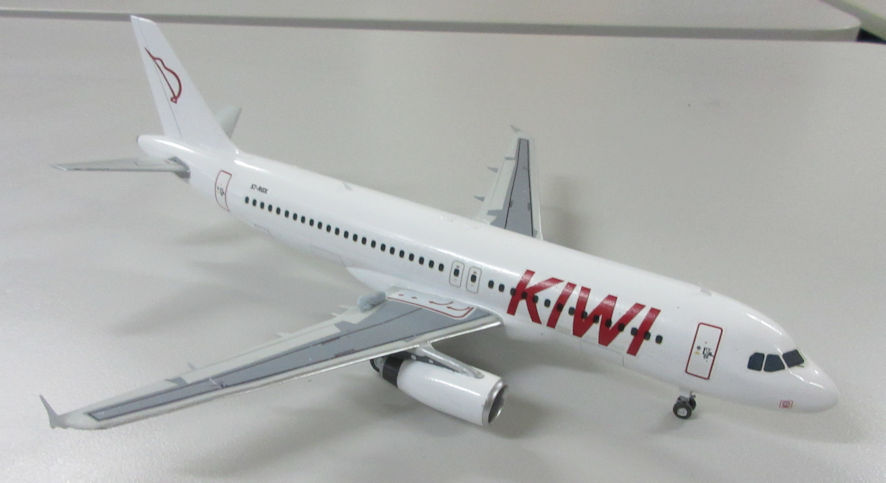

Oldmodels offer sheets for Freedom Air A.320s which are probably very nice, judging by other Oldmodels decals I’ve used. However, I already had the Draw Decals set so I decided to use it, and felt few ill effects as a result. The instruction sheet says to use Tamiys TS-47 for the fuselage yellow and TS-15 for the tail, which looks pretty good to me. In making this model I used aftermarket metal undercarriage part for the first time. I am not a great fan of spending money on parts which look little better than the plastic parts in the kit, but the nose undercarriage has to be fitted at the stage in the assembly process of joining the fuselage halves together and is very fragile, so the nosewheel legs had not survived handling during the rest of the model making process for all my previous A.320s. The metal nosewheel leg I used this time survived all kinds of abuse, so I will be using them for the rest of these A.320s.


The PAS Decals resin 1/144 kit of the Airbus A.310 is probably more accurate than the Revell kit, if you can find a copy without paying a small fortune for one on ebay. However, it is not easy to put together and even liberating the parts from their casting blocks is manual labour. I don’t recall why I bought this expensive kit, but since I could not find a sucker to buy it from me, and I already had FedEx decals for an A.310, I cast caution to the wind and made it. It has not been one of my most enjoyable model making experiences.


I thought I’d made all the Revell 1/144 Fokker 100s I needed to make until I happened to be looking at Ric Warcup’s Facebook page and saw that he offered decals for a couple of relatively rare operators in Australia. Flight West was launched in Queensland in 1987 but went into liquidation in 2001 (it was sold to the parent company of Alliance Airlines, which Ric Warcup also offers decals for, of which more later). There is nothing exceptional about making this model except that the Warcup wing marking decals do not fit the wings comfortably so I used kit decals instead. Like the Revell A.320s mentioned above, the nose undercarriage looks nice and accurate but is also has little strength as a result, so I had to find something a bit more sturdy in my spares box after I accidentally destroyed the kit nose undercarriage.


I’ve written separately about mis-making this Welsh Models 1/144 Boeing KC-135A. It is a vacform and white metal kit, which would pose all kinds of problems for a modeller not experienced in these media so perhaps the simpler Minicraft kits would suit most people. Despite it’s problems, it doesn’t look too bad.


Here are two I made earlier.
This is the venerable Airfix/MPC 1/72 Dornier Do17F. So far as I am aware this is the only F model available, the other Do17s I’ve seen have been the Do17Z with the radial engines. I have a memory of finding this kit at the back of a shop in Honolulu when Valma and I visited the United States in 1974, the decals may have come with the kit but the transparencies come from the Falcon vacformed set for Luftwaffe bombers that is, I assume, no longer available. (The lesson, buy things when you see them because you never know when they will be sold out.)


Here is another of my set of BAC Lightnings, mostly made from the Trumpeter kit. This Lightning F.6 used the kit decals for XR753 flying with No 23 Squadron, RAF, around 1970.
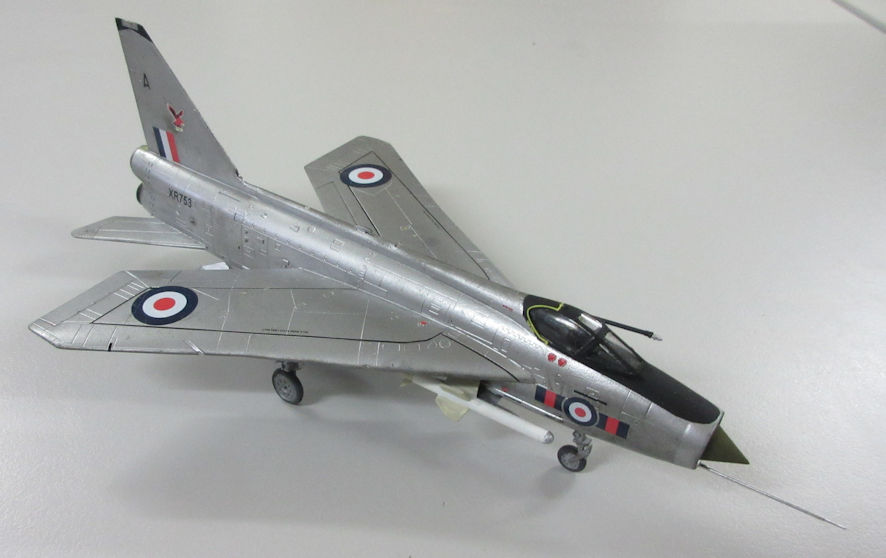

March
Let’s begin this month with a couple more Airbus A.320s. Both these are the Revell 1/144 kit of this airliner, they don’t need much work to get them looking good except removal of the surplus flap tracks. Some of the Revell kits – but not all – come with the IAE and CMF engines so that is always a point to look out for when making models from these kits.
First an Ansett Australia A.320 with the ‘Flag tail’ livery. Unlike most A.320s which had white fuselages and grey wings, the Ansett A.320s (and probably all their other airliners at this time) were painted white all over, which makes the task of painting them a little simpler. The decals for this model come from Hawkeye.


The New Zealand decal maker Oldmodels makes decals for all the liveries that Air New Zealand has flown it’s a.320s in. This set portrays ZK-OJH in the Star Alliance livery. All Star Alliance members have one of two of their aircraft painted in this standard livery with the name of the participating airline in smaller font lower towards the nose.


Compass II flew for only a few months in Australia in the early 1990s after the failure of the first Compass Airlines. The new airline’s fate was the same. But while it was flying it used a small fleet of McDonnell Douglas MD-83s which are advanced versions of the old Douglas DC-9 that served on Australian airlines for many years. The kit for this model is the Minicraft 1/144 kit and the decals are from Hawkeye.


If you, like me, has been watching Big Jet TV on You Tube you will have seen quite a few of the new Airbus A.220s coming and going. The red Swiss markings on the white fuselage looks particularly attractive I think, so when Eastern Express released a 1/144 kit of this aeroplane I was unable to resist its attractions. It turned out be a fairly decent kit too and easy enough to make with the decals for both Swiss and Delta airliners in the box.


FSC Dujin have been rereleasing some of the little jems that Jean-Pierre Dujin originally released a couple of decades back. They are not the easiest of kits to make and they are resin, which puts some people off, but they are of subjects that no other kit manufacturer makes and for that reason I love them. The new versions come with decal sheets, some etch parts and much more comprehensive instructions than the earlier versions. This little model is a Mudry CAP 231EX aerobatic aeroplane in 1/72 scale.


Even rarer than the FSC Dujin kit is this 1/72 Farman 370 which was supplied to me by the French modeller Adrien Roy. It is fully resin and a little challenging to make, but well worth the effort if you are, like me, interested in French racing aeroplanes from the interwar period. The colour if Tamiya’s rattle can French Blue.

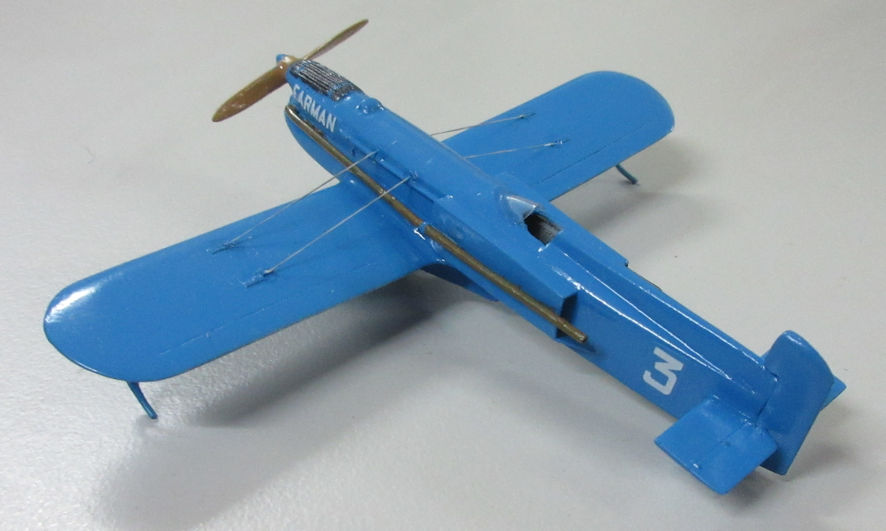
Here’s one I made earlier.
This is the Special Models 1/72 Bell XP-77 which I made in 1989. This was probably the first Special Hobbies kit I made and an early experience in the short-run injection moulded kits that started to emerge from Eastern Europe. It was a shock to the system I can tell you.


April
It’s been a rather slow month for A.320 models but there should be a herd of them soon. One that did get through is this Revell 1/144 Air New Zealand A.320 in the Silver Fern livery. The decals come from Oldmodels, the windows and doors from Ric Warcup and the corogard panels and wing lines come from 8S.


Instead of A.320s I’ve been having a run on Dewoitine 520s in various versions. First off is a simple conversion of the Hobby Boss 1/72 Dewoitine 520 converted to a D.520DC using the vacformed canopy from the A+V resin kit. The A+V kit is not very good so it is better to use parts from the A+V kit to turn the Hobby Boss kit into a D.520DC. The photos I could find suggest that these aeroplanes had no distinctive markings so finding markings for this model was a simple matter of rummaging through the spares box.


Much more challenging was the Dewoitine 780 which is a combination of the CMR resin and the Hobby Boss kit. As with the A+V kit for the D.520DC, the quality of the CMR kit fuselage is so poor (and not for a D.780 anyhow) that it was easier to replace it with the fuselage from a Hobby Boss kit. When I say ‘easier’ you have to understand that this is a relative term and it was, to tell the truth, a fairly difficult conversion that I wouldn’t recommend to anyone. The colours are fairly speculative but are in the fashion of Aeronavale seaplanes of the time.


Here are three that I made earlier.
This is the ancient Tasman Models 1/72 kit of the Commonwealth Aircraft Corporation CA-19 Boomerang. I made this while in the grip of a case of AMS (Advanced Modellers Syndrome) so a lot of effort went into making this fairly ordinary kit acceptable.


Next is the ancient Matchbok 1/72 Boeing P-12E. I made this straight out of the box in 1975 but was well enough down the track that I knew models have to be painted. There’s no rigging on this, I wasn’t up for it then and I’m still not up for it now.
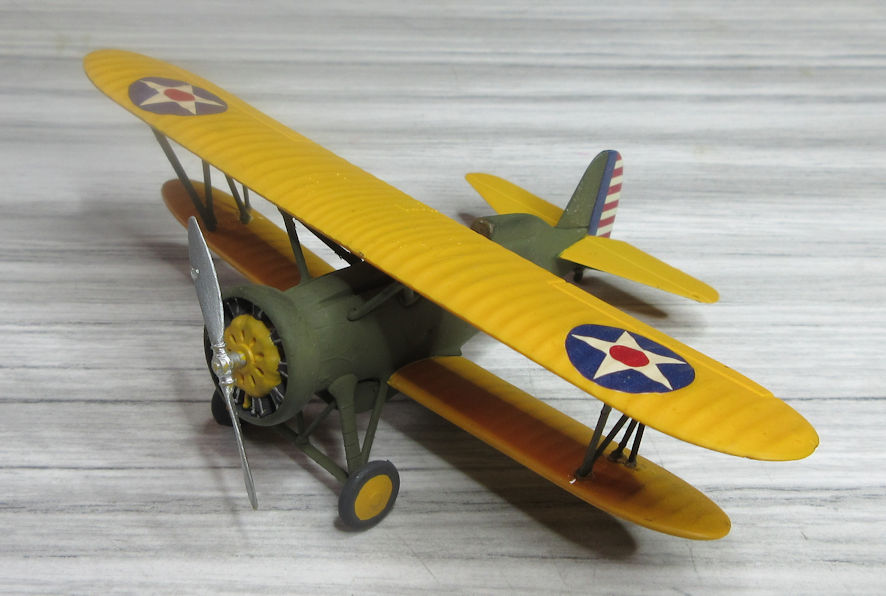

Finally, another Matchbox kit, this time the 1/72 McDonnell F-101 Voodoo with some very nice aftermarket decals. The key problem with this one when I made it was ‘what is ADC grey?’ Since then paint makers have begun offering this shade of grey in their paint ranges, had I waited a few years I wouldn’t have had to spend so much time worrying about this simple matter.


May
The Minicraft 1/144 Douglas DC-8 kit is about the best game in town though there are Welsh Model offerings, if you like resin and vacform, and there is probably the old Revell kit too. The nice thing about the Minicraft kit is that there are indentations inside the fuselage halves to show you where to cut to make the versions with the shorter fuselages, though which cuts to make is left up to the modeller. There are also wing tip extensions so that, after a bit of research, you can work out how to make all the different versions of the DC-8. The engines are a different thing and though various versions of the kit offer engines for the -60 and -70 versions, you have to go to aftermarket sources for engines for the earlier versions.
For this early -10 version I used Contrails engines and Vintage Flyer decals. The Contrails engines and the kit wings wanted nothing to do with each other and that was a problem long in the resolution. On the other hand the decals were excellent and went on with no trouble. The decal set also comes with some paint masks which help make the demarcations between the white and silver much easier than usual to work out. After having applied the decals I found out that the option I had made, Delta Air Lines N801E, had made the first passenger carrying DC-8 flight on 18 September 1959.


This Revell 1/144 Airbus A.320 kit is straight out of the box though with the CMF engine option. The paint scheme is over all white, which is how the Ansett A.320s appeared. The only thing that is unusual about this model is the decals which represent the first livery that Ansett A.320s appeared in. Hawkeye make decals for almost all post-war Australian airliner liveries but not for this first iteration of Ansett’s A.320s. Around the same time as that airline introduced the A.320s it also introduced to service Boeing 737-200s and I hoped that if I bought the Hawkeye decal set for that airliner it might fit on the A.320. Unfortunately it did not, the A.320 being a generally bigger airliner than the 737-200. However, I scanned my copy of the decals and, after some experimentation, enlarged the tail markings to 106 per cent and the fuselage logo to about 125 per cent, printed them out and they fit very nicely. (By the way, I well remember my first flight in an Ansett A.320, on the long flight from Melbourne back to Perth. After the sardine can experience of a 737 flight across to the eastern states the A.320 was spacious and very comfortable, even in cattle car, and the Ansett cabin service was excellent, as always.)


The Dewotine 551 was the military version of the Dewoitine 550 which was built to make an attempt on the air speed record. That was, in turn, a conversion of the Dewotine 520 fighter with reduced wing span and weight and more powerful engine. When the test pilot took the Dewoitine 550 up for its first flight in October 1939 he was astounded at its performance and naturally the military took an interest. By the time of the French defeat in June 1940 a handful of prototype Dewoitine 551s had been made but they never flew and the Germans ordered them to be scrapped. However, this fighter would probably have been France’s front light fighter had the war started a year later and so it is interesting from that point of view.
This fully resin kit comes from the group of enthusiasts calling themselves FGM who came together after Jean Pierre Dujin died to reissue some of his kits. Although they are resin kits, their Dujin reissues are fairly easy to put together once you get some experience in the processes involved. This kit, however, is not a produce of the Dujin workshop and is, if nothing else, a reminder of what a skilled craftsman he was. I had to extensively extend my vocabulary of foul language while making this kit. It is a real pain to assemble and would have met its fate in my rubbish bin at almost every stage of construction had I not really wanted to add this model to my collection of French aeroplanes. Let’s not go into detail, suffice it to say that the end result looks reasonably like a Dewoitine 551 might have looked like.


Here are three I made earlier.
I don’t know if there is another kit in 1/72 other than this Airfix Hawker Siddley Gnat T.1. It is ancient by almost any standards and needed a lot of work to make the end result look as though it had come from a more modern kit. This is also your classic tail sitter with almost no space in the nose for weight to counter the trend, but a couple of white metal after market seats helps make the inside of the cockpit make more realistic and keep the nose down. Looking at the model now I suspect that the red I used while making it is more scarlet that the Red Arrows colour scheme actually is.


Here is another ancient Airfix kit, the 1/72 Dassualt Super Mystere. I think that Special Hobby make a more modern kit but kits from that manufacturer are not the easiest to make. In any event, I had bought this kit many years earlier and it is like a lot of Airfix kits from this era, good honest kits but lacking a lot of the detail and fineness of more modern kits but not to be laughed at. The decals came from one of the Model Art sets, a company that specialized in French aircraft.


The Boeing X-32 was a concept demonstrator built to compete in the competition that was eventually won by the Lockheed Martin X-35, which became the F-35 that many people love to hate. The X-32 might have been an excellent aircraft but it is also one of the more ridiculous looking ones and it is probably just as well it did not go into production because who could take seriously an air force what flew aeroplanes looking like that. In any event, this is the Italeri 1/72 kit made straight out of the box.


June
Let’s begin with something in 1/72. This is the Kora model of the Dewoitine 53. I seem to be having a slight obsession with Dewoitine these days, and this is the latest product of this fixation. The Dewoitine 53 was not a particular success and only a few were made before moving on to more advanced fighters. This model is an reminder that one should always do some research and read the instructions fully, even if you think you know what you are doing. Only when I had finished the model did I find that the Armee de l’Air only took delivery of one of these aeroplanes and did not accept it into service. Consequently the scheme offered with the kit that I decided to use – because it was more colorful – is what they call a ‘what if scheme’. As a result I am not really happy with this model but I’m not going to repaint it, that would be too challenging.


F-RSIN make some beautiful little resin airliner models and this is one of them. The deHavilland DH-91 was a late pre-war design and only flew in service for Imperial Airways for a year before the Second World War over took it. Only seven were made and five of those were either destroyed by enemy action or in accidents. When it was discovered that the final accident was caused by failure of the wooden construction the other two were grounded and scrapped. A pity. This is a simple little kit but has to be put together carefully. It also lacks any of the exhaust pipes the original aeroplane had so I had to scratch build them. I experimented with AK Xtreme Metal’s paint for this one and was only later reminded that it is an enamel and not as tough as a lacquer paint. As a result it suffered from handling during applying the decals, though you can’t really see the damage in these photos.


This little Fokker 70 was made by cutting plugs out of a Revell kit of the Fokker 100 to reduce it to the appropriate length. It was a trial by ordeal that I’ve written about separately. The decals come from Ric Warcup and, although they are designed for the Revell Fokker 100, are mostly useable for the Fokker 70.


Here are two models of Airbus’s A.321, a stretched version of the Airbus A.320, made from thr Revell kit. Somehow, in my scrounging around at Swap and Sells I ended up with two A.321’s when one would have been sufficient for my purposes. The decals for both these models are from F-DCLS, the same people who produce the F-RSIN kits, and they are very high quality that I would recommend to anyone. The only warning is that I always apply a light coat of gloss clear varnish over all the decals I use and on this occasion it effected the red which blurred a little. Not the other colours, but this could be a problem in using these decals, so proceed carefully.
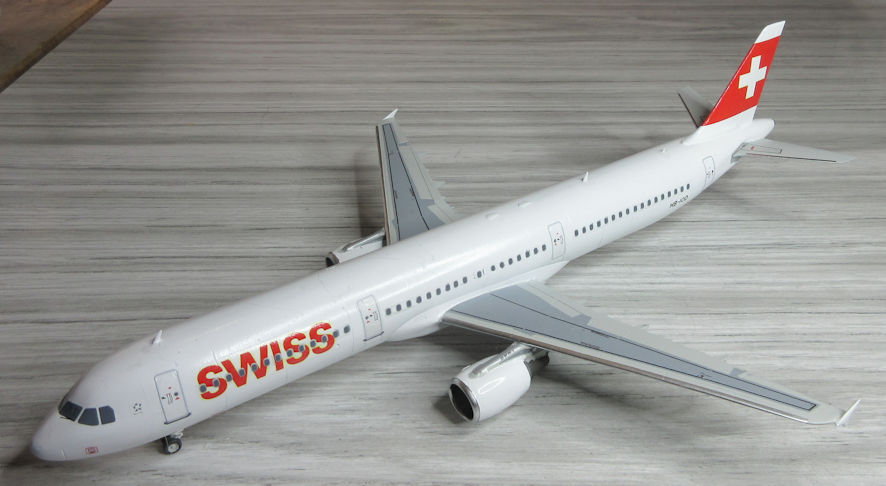



Finally, another Revell 1/144 Airbus A.320, this time in the early livery flown by Air New Zealand before they moved over to the newer black and white schemes. The decals are from Oldmodels, a New Zealand company.
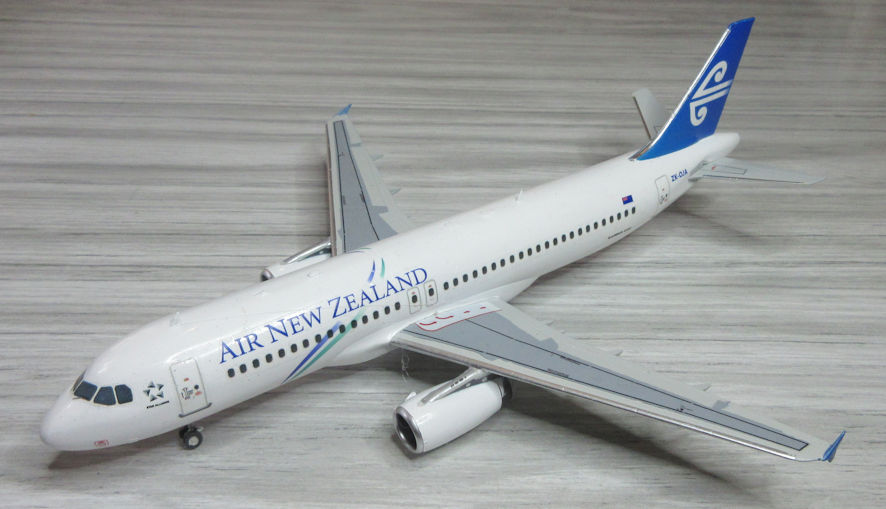

Since I usually finish with something I made earlier, here it is.
This is a Revell 1/144 Airbus A.330-300 kit converted to an A.330-200 by removing fuselage plugs before and after the wings, much as I did for the Fokker 70 this time. I made this model in 2003 which was about when I began trying to make models of airliners. I had a few things to learn here; the first one is that white enamel paint yellows over time, which is why I now use lacquers which don’t appear to suffer from this problem. For some reason I don’t understand the white on this model is matt rather than gloss, perhaps I only had matt paint on hand at the time or perhaps something has happened to the paint between then and now. With this one I also filled the windows with white glue to simulate the appearance of windows, which I don’t really think works in 1/144. There are several other problems of technique that I have, hopefully, improved over time. When I’ve finished making all the A.320s I’m currently planning I’ll move on to some more A.330s which will, I hope, be an improvement on this one. I will keep this one as it is, however, as a reminder that even my model making improves over time, a little at least.


July
This month we begin with a feast of four Airbus A.320s. All the Revell 1/144 kit and made with the CFM 56 engines. There’s already been plenty of these and these have been made in the same way as those previous ones.
First an Air Inter A.320 finished using 8A decals. This is the final Air Inter scheme before that airline was acquired by Air France.


Next two Ansett Australia A.320s with the final scheme, provided by Hawkeye with the wing decals by 8A. Since making these I’ve been told by somebody who knows that this batch of A.320s was delivered to Ansett with grey wings rather then the white wings of the earlier batch. Unfortunately, all the photos I looked at did not tell me of this development and Graeme didn’t tell me until it was too late. This is how VH-HYA would have appeared in 2002 it if had had white wings.


I’m not a great fan of one off schemes but could not resist this MASP decal sheet for VH-HYN which flew the Olympic Torch around our wide brown land in the months before the Sydey Olympic Games in 2000. Again, it should have grey rather than white wings but I won’t tell if you don’t. The decals are a combination of MASP, Hawkeye and 8A.


Finally an A.320 in the livery of Strategic Airlines. The decal sheet is from Decales Global and intended for a Luxembourg airline of the same name and livery. I’ve managed most of the amendments that appear on the Australian registered aircraft, VH-YQA is it appeared in 2011, but could not make the little Australian flags that appear on the wing end plates so you will have to imagine them.


This Dewoitine 376 was made from the Azur 1/72 kit. It is a fairly easy kit to make apart from mounting the parasol wing on the fuselage. It is painted overall in Tamiya LP-38 Flat Aluminium and the cowling in Tamiya TS-83 Metallic Silver to give a bit of tonal variety. It represents No 31 in service with AC 1 at Lanveoc Poulmic in 1939.


This BS Design 1/144 Schleicher ASW 28 glider is one of the smallest (if not the smallest) model I’ve ever made. It has only four parts but is not easy to put together because it is so tiny and the parts fit is not great. I added another two parts, the undercarriage doors to give it a slightly greater sense of authenticity. The decals that come with this kit are for the prototype which first flew in 2000.
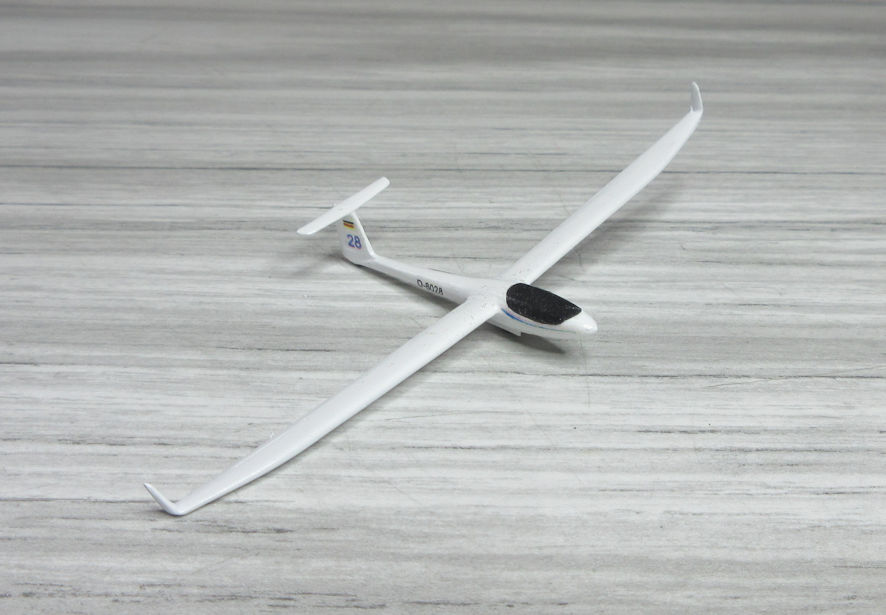

And here’s one I made earlier, the Condor 1/72 kit of the German A-4 ballistic missile also known as the V-2.

August
This month has been a less productive one than most. This is because I decided to make a change and make some smaller models which, I thought, would take less time to make. I was wrong, the smaller models took more work than usual and hence more time.
The first example is this tiny Stransky 1/144 Learjet 35. I thought that putting it together would take no time at all, but it turned out that getting the fit right took almost as much time as it would on a larger kit. Then there was the masking and painting which was extremely fiddly and quite stressful. The result was that this model spent a lot of time sitting on the shelf while I worked up the nerve to get back to it. If I was going to do this again I’d find a 1/72 kit which might require a bit more work but would not be quite so much of a challenge. On the other hand, this kit comes with this lovely Wards Express livery which I haven’t seen in the larger scale.


French modeller Adrien Roy has sent me three of his newly created kits of French aeroplanes from the interwar period and, of course, I could not resist starting one immediately. This 1/72 Bernard 20 is a beautiful little resin creation, finely crafted and moulded and is a real joy to put together. If I had to make a list of my favourite kits of 2020 this would definitely be towards the top of the list. If you’re looking for something a little out of the ordinary, but very pretty, I’d recommend you get this, but only if you know what you’re doing with resin. The thing that took me so long with this kit is that I worked at it very slowly for fear of making a mess of such a lovely kit. I’m a little suspicious of the colour, Roy’s model is a lot more subdued in tone than mine but, as he says, we don’t have any colour photographs of this aeroplane so I’m as likely to be right as he about the exact colour.


This new KP MiG-19S is a kit that I’ve been waiting years for. I think the MiG-19 is one of the most elegant looking of the 1950s jets and this new kit certainly portrays that look. The kit itself if fairly simple to put together and the fit part is very nice. One of the main reasons that it took me so long to complete this is that I was unsure of the way that the finished model should look and took a lot of time cruising the interweb trying to find some guidance. However, there were so many MiG-19s made and they stayed in service so long that there is a photo of this fighter in almost every finish and condition that you can imagine. This is another kit I would recommend and, unlike the Bernard 20, it was an important aeroplane historically and now that KP have released this new kit there is no excuse for you not to add one to your collection.


Here are some I made earlier.
This MiG-15 is the much older KP kit that has been around for many years and had been well and truly superceded by the newer Airfix kit. As you can see from the look of this model, I was experimenting with bare metal finishes and this highly polished one didn’t turn out so well. I made this one about twelve years ago and since then I’ve settled on the range of Tamiya lacquer metalic finished that stand up to the wear and tear of modelling a lot better than this one did.


One of the reasons I like making models in constant scale is because it allows me to see the relative differences and changes that took place in aeronautical production over time. By coincidence I pulled out the KP MiG-15 just as I completed the MiG-19 and it is interesting to put them together. It would be interesting to put the MiG-17 in as well to see the progression between the earlier and the later design but I think that these couple of photos shows the similarity between the two MiGs and the advanced that took place in aeronautical design in only a few years.


It is interesting to see the BAC Lightning in comparison with the MiG-19 and see the comparisons, although the contemporary of the Lightning is really the MiG-21. This is the 1/72 Trumpeter Lightning F.6 of No 11 Squadron RAF, right at the end of its service life in 1987.


This little Dujin 1/72 SAN Jodel 140 is an example of why I am such a fan of Dujin kits. They are quite rare these days and fetch good prices on ebay but some are being re-released by a consortium under the FGMmasterdujin label. However, both those and the original Dujin kits are hard to find these days. Fortunately I have quite a few stored up for my eventual retirement.


September
Among the little treasurers that Jean-Pierre Dujon left us is a conversion kit to turn a KP Skoda D.1 into a Dewoitine 9. The main components of the kit are new fuselage halves, new tail fins and a new rotary engine and cowling. It is not really a hard conversion to make, the main thing I needed was a bit of courage to do it because I knew there was no coming back if I made a mess of it – I’ve seen the KP kit on ebay but not the Dujin conversion kit. I was at a loss about what marking to give it until I was looking at some kits in my Treasure and noticed an Azmodels Morane G/H which had a Swiss decal option. The Swiss decals were just the right size, as you can see.


The deHavilland DH-86 is an important aeroplane in Australia’s civil aviation history and so I’ve been keen to make one for many years. Recently Arctic Decals released a simple but effective kit in 1/144 and here is the result. The markings of for one of the Holyman’s Airways DH-86s that crashed fatally, this on in October 1935.


Making a couple of JetStar Airways Airbus A.320s was part of my plan to make a set of all the A.320s that had flown in Australia and New Zealand. When I got around to doing the research I discovered that JetStar A.320s all look more or less the same except for the airline’s logos on the fuselage side. Hawkeye make options for the two most commonly used logos and I discovered that the Oldmodels Jetstar A.320 decal sheet has the logos for the other two less common ones. (Jetstar A.320s have also appeared with ‘JetStar Asia’, ‘JetStar Pacific’ and ‘JetStar Japan’ logos but a modeller has to draw the line somewhere. The kits are from Zvezda, the main fuselage colour is Tamiya rattle can Mica Silver and the decals come from Hawkeye, Oldmodels and 8S.
To begin, here’s VH-JQL in the original JetStar livery.


Next, here’s VH-VGR in the current main JetStar livery.


Here’s VH-JQL again, this time in an interim livery in 2016.


Finally, here’s VH-VFF in another livery from around 2012.


And here’s one I made earlier.
I made this Matchbox Grumman F9F-4 in August 1982 so I don’t remember much about it. The paint is probably good old Modelmasters enamel paints and the decals look to have come straight out of the box too.


October
Here are three new models made from kits that do not go together without a fight.
Let’s begin with the little Azmodels 1/72 Morane G. This little pre-World War I fighter might look simple but it is not simple to make because it is a limited-run injection moulded kit with fairly vague instructions. I had to take care to look at photos of the real aeroplane and test fit the parts a lot before they went together reasonably well. The Morane G was a sports plane before the war which then ended up being impresses into military service so the kit comes with military decals, but I thought it looked nice without them.


This Valom 1/72 Boeing XF8B might be a big and fairly simple looking aeroplane but it is a challenge to put together. It is also a limited-run kit and the kit maker has left out a lot of detail that can be added if you like. It comes with a fairly good seat and floor and instrument panel for the cockpit but the rest is a big gaping hole that has to be filled with some scratch built stuff. The wings are also a challenge and the trailing edges needed a lot, and then a lot more, thinning before they looked reasonable. Since the finish is the US Navy’s gloss deep sea blue there also had to be a lot of preparing the surface before applying the paint because any blemishes show up readily.


I’ve been having something of a US Navy month so, going from large to tiny, here is a 1/144 Vought F7U-1 which comes as one of the little bonus kits in the Anigrand 1/144 Big Plane range. Despite its tiny size it needs a lot of care in assembly to get the parts lined up properly. Since this is a full resin kit everything had to be stuck together using superglue an in this tiny size it is difficult to glue the pieces together without getting some on your fingers and ending up with the fingers stuck to the model or to each other. Like the F8B above, this was painted in AK Real Color Deep Sea Blue lacquer which I really like.


Here are three that I made earlier
While we’re in the Morane mood here is the old Revell 1/72 Morane N. I made this model in 1975 when it was a relatively modern kit, having been released in 1965. According to Scalemates this is still the only kit available of this aeroplane.


Another kit that you won’t find easily these days is the Matchbox Fiat G-91Y which first appeared in 1979 and was last reboxed in 1997.


Even rarer these days I suspect is the old Welsh Models vacformed 1/144 Vickers Valiant. It has now been superceded by resin and plastic kits that will be much easier to assemble but back then this was the only kit available.


November
This month begins with another 1/144 Airbus A.320, this one in the livery of the Air New Zealand ‘Crazy About Rugby’ airliner. The kit is you standard Revell kit and the main decals are from PAS Decals in Russia.


Staying in 1/144, here are two little experimental British aeroplanes that come as bonus kits with the Anigrand resin kit of the Avro Vulcan B.2. The first is the Avro 707 which was the proof-of-concept test aeroplane for the Avro Vulcan, you can’t miss the similarity. This is a simple little kit of the first version of the Avro 707 which went through another three versions after this one.


This deHavilland DH-108 (Swallow) is also part of the same kit as the Vulcan and another simple little kit of an interesting little aeroplane. This one took parts of the deHavilland Vampire incorporated into a tailless swept wing design to test the concept for an airliner and then the deHavilland Sea Vixen. Both this and the Avro 707 are finished in Tamiya’s AS-12 Bare Metal Silver lacquer paint.


For some time I’ve been gathering RS Models kits of the Dewoitine 520 and decals to go with them, ending up with five kits and some interesting decals. I find it more efficient to make kits in a batch when I’m planning to make more than one and so here are five Dewoitine 520s in different liveries.
When France capitulated to the Germans in June 1940 the Luftwaffe took over quite a few Dewoitines that it used as trainers. Here’s what one looked like at StMartin-du-Touch in 1941.


The Vichy government in France went over to fighting on the German side, mainly in North Africa. They wore increasingly garish yellow and red marking with the standard blue, blanch, rouge roundels. This one is supposed to represent experimental new French markings applied to one Dewoitine in Tunisia in December 1941. (I don’t know whether this is true or not, but it looks interesting.)


Sixty Dewoitines ended up flying for the Reiga Aeronautica (Italian Air Force) as interceptors, replacing antiquated Macchi 200s. Here is what one flying at Mateto in July 1943 looked like.


Ninety-six Dewoitines were delivered to the Bulgarian Air Force where they were used to intercept attacking American bombers in 1944. Here is one that was based near Karlovo that year.


A few Dewoitines ended up in the hands of Free French Forces towards the end of the war, including a number flying with Groupe Doret in the south of France attacking German troops on the ground. Here is what one looked like in October 1944.


The Goodyear F2G ‘Super Corsair’ was a development made by Goodyear (which licence built Vought F4U Corsiars) to create a faster low level interceptor. The main change was to instal a four row radial engine and an all-round vision canopy. Only five were made because production orders were cancelled at the end of the war, they did not live up to promise and the Grumman F8F Bearcat offered superior performance.


December
I’ve been meaning to replace my old model of the Hasegawa 1/72 Vought XF5U-1 for some time but finally remembered to do something about it and acquired another copy of the kit over the internet. It is not a difficult kit to make and this one is painted in SMS lacquer Dark Sea Blue which makes a good finish to the model almost inevitable.


With the big Anigrand 1/144 kits you get three bonus smaller kits, also in 1/144. Sometimes they are kits of subjects so small that they would be better made in 1/72 but what to do with these little kits that just lay around and get annoying after a while. I could either throw them out, find another home for them or make them, and on some days making them seems to be the simplest solution. The result is two of these annoying little kits turned into passable 1/144 models. First the Anigrand 1/144 North American Navion light aircraft that was operated by the United States military as the L-17.


Another of these tiny Anigrand 1/144 kits is this Saunders Roe SR.A/1 flying boat fighter. I’d lost the decals for this one so they all had to be hand crafted, so they’re not perfect but a lot better than nothing.


And here are three I made earlier
The Azur 1/72 Arsenal VG-33 in Battle of France camouflage.


The SPARTA/WRESAT satellite launcher in 1/144 by New Ware. The Americans conducted some launches at the Wommera rocket range using Jupiter launchers and had one left over at the end of their program. Not wanting to waste it, the boffins at the Weapons Research Establishment put together a small satellite that was launched using the remaining Jupiter. This made Australia among the first countries to put something into orbit, not that the country has done much since.

The AMT 1/72 Northrop YB-49 flying wing bomber. This looks pretty good in an Alclad II finish, but it’s not a paint you want to mess with under normal circumstances.

